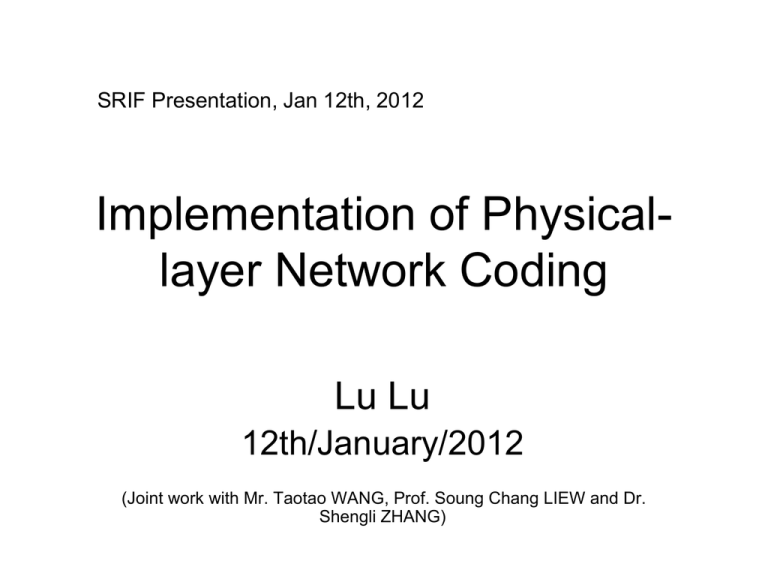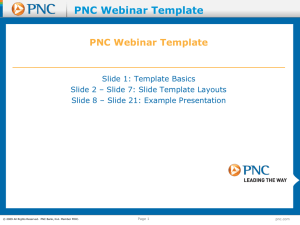slides - Software Radio Implementation Forum
advertisement

SRIF Presentation, Jan 12th, 2012
Implementation of Physicallayer Network Coding
Lu Lu
12th/January/2012
(Joint work with Mr. Taotao WANG, Prof. Soung Chang LIEW and Dr.
Shengli ZHANG)
Outlines
• 1. Background of Physical-layer Network Coding (PNC)
• 2. PNC Realization Challenges
– Asynchrony, Channel Estimation, Joint Channel-decoding and Network Coding (JtCNC)
– Our approaches to tackle them
•
PNC in the frequency-domain (FPNC) with OFDM, Design the Frame Format to suit for PNC and XORCD decoding
• 3. Effect of Delay Asynchrony in Frequency Domain
• 4. Experimental Results
– FPNC Implementation over Software Radio Platform
– Experimental Results
• 5. Conclusion and Future Works
2015/4/13
2
1. Introduction to PNC
End Node
A
Relay Node
R
End Node
B
Figure 1: PNC illustration.
• PNC, first proposed in [PNC]. The simplest system in which PNC
can be applied is the two-way relay channel (TWRC), in which two
end nodes A and B exchange information with the help of a relay
node R in the middle, as illustrated in Fig. 1.
• Prior to this paper, only a simplified version of PNC, called analog
network coding (ANC) [ANC], has been successfully implemented.
The advantage of ANC is that it is simple to implement; the
disadvantage, on the other hand, is that the relay amplifies
[PNC] S. Zhang, S. C. Liew, and P. P. Lam. “Hot Topic: Physical Layer Network Coding,” in Proc. 12th MobiCom, 2006.
[ANC] S. Katti, S. Gollakota, and D. Katabi, “Embracing Wireless Interference: Analog Network Coding,” in ACM
2015/4/13
3
SIGCOMM, 2007.
2. PNC Realization Challenges
• Asynchrony
– Without precoding and synchronization of the two end nodes, signals
from nodes A and B may arrive at the relay R with symbol and carrierphase misalignments.
– Solution: PNC with OFDM (FPNC)
• Channel Estimation
– In PNC, the relay needs to estimate two channels based on
simultaneous reception of signals (and preambles) from the two end
nodes.
– Solution: FPNC Frame Format Design
• Joint Channel-decoding and Network Coding (Jt-CNC)
– In our FPNC design, we adopt the convolution code as defined in the
802.11 a/g standard.
– Solution: Using simple XOR-CD decoding
2015/4/13
4
Asynchrony
Freq.
Freq.
X A [1]
X B [1]
x A [1] x A [2]
x A [n 1] x A [n ]
...
...
xB [1] xB [2]
X A [n ]
X B [n ]
Symbol duration in FPNC
(a)
...
xB [n 1] xB [n ]
Time
Symbol duration in TPNC
Time
(b)
Figure 2: PNC with time asynchrony: (a) frequency-domain physical-layer network
coding (FPNC); (b) time-domain physical-layer network coding (TPNC).
•
To deal with asynchrony, our FPNC implementation makes use of OFDM to
lengthen the symbol duration within each subcarrier. Then, independent
XOR PNC mapping is performed within each subcarrier. OFDM splits a
high-rate data stream into a number of lower-rate streams over a number of
subcarriers.
2015/4/13
5
Channel Estimation
320 samples
10 short training symbols
160 samples
2 long short training symbols
128 samples
Node A s1 s2 s3 s4 s5 s6 s7 s8 s9 s10 CP
Node B
L1
s1 s2 s3 s4 s5 s6 s7 s8 s9 s10
L2
0
0
0
CP
L1
data
L2
0
data
Cyclic prefix
16 samples
Figure 3: FPNC preamble format.
•
•
In our implementation, we solve this problem by assigning orthogonal
training symbols and pilots to the end nodes, as shown in Fig. 3.
In PNC, we have two CFOs at the relay. To strike a balance, our solution is
to compensate for the mean of the two CFOs {will be elaborated later}.
2015/4/13
6
Joint CNC
YR
YR
Channeldecoding and
Network Coding
Symbol-wise
XOR PNC
Mapper
S A SB
X R C ( SR )
Channel
Encoder
S A SB
XA XB
Channel
Decoder
CNC
Figure 4: (Upper) Link-by-link channel-coded PNC, including channel-decoding and network
coding (CNC) process and channel encoding. (Lower) XOR-CD design for CNC.
•
In FPNC, we choose a design that is amenable to simple implementation,
as shown in Fig. 4. We refer to this CNC design as XOR-CD.
2015/4/13
7
3. Effect of Delay Asynchrony
• Effective Discrete-time Channel Gains
x A (t )
x A [n ]
g A (t )
p (t )
MF
xB (t )
xB [n ]
p (t )
g B (t )
w(t )
hA [ n ]
x A [n ]
y R (t )
y R [n ]
y R [n ]
xB [n ]
hB [n ]
(a)
w[n ]
(b)
hA [ n ]
Figure 5: (a) Continuous-time channel model for PNC.
(b) Equivalent discrete-time channel model for PNC.
• Delay-Spread-Within-CP Requirement
2015/4/13
0
1
2
3 …… DA-1 DA DA+1
0
1
2
3 ……
n
hB [n ]
n
DB-1 DB DB+1
8
FPNC Expression (Freq.)
• We remark that our discussion so far in this section has assumed
the absence of CFO. When there is CFO, inter-carrier interference
(ICI) may occur, and this will be further discussed in the following
slices.
2015/4/13
9
FPNC Mapping
•
In our implementation, we adopt a simple “log-max approximation” that
yields the following decision rule:
2015/4/13
10
4. Experimental Results
• FPNC Implementation over Software Radio Platform
• We implement FPNC in a 3-node GNU Radio testbed, with Software
Defined Radio (SDR). The topology is shown in Fig. 1. Each node is
a commodity PC connected to a USRP GNU radio.
– Hardware: We use the Universal Software Radio Peripheral (USRP) as our radio
hardware. Specifically, we use the XCVR2450 daughterboard operating in the
2.4/5GHz range as our RF frontend. We use the USRP1 motherboard for
baseband data processing. The largest bandwidth that USRP1 could support is
8MHz. In our experiment, we use only use half of the total bandwidth for FPNC
(i.e., 4MHz bandwidth).
– Software: The software for baseband signal processing is based on the open
source of GNURadio project. We build our system by modifying the 802.11g
transmitter implementation in the FTW project [FTW]. The FTW project [FTW1],
however, does not have a 802.11g receiver. Therefore, we develop our own
OFDM receiver, designed specifically to tackle various issues in the FPNC
system, such as CFO estimation and compensation, channel estimation, and
CNC processing.
[FTW] P. Fuxjaeger, et al., FTW IEEE802.11a/g/p OFDM Frame Encoder. (available at
2015/4/13
https://www.cgran.org/wiki/ftw80211ofdmtx)
[FTW1] P. Fuxj¨er et al., “IEEE 802.11p Transmission Using GNURadio,” in Proc. IEEE WSR, 2010.
11
Time-Synchronous FPNC versus TimeAsynchronous FPNC
Synchronous FPNC
0
Asynchronous FPNC
0
10
10
-1
-1
10
-2
10
-3
10
10
-2
10
BER
BER
-3
10
-4
10
-4
10
-5
10
-5
10
-6
10
-6
channel uncoded (symbol align)
channel coded (symbol align)
10
15
20
SNR [dB]
10
25
channel uncoded (symbol misalign)
channel coded (symbol misalign)
10
15
20
SNR [dB]
25
(a)
(b)
Figure 8: BER of FPNC with and without sample synchronization. The 95% confidence intervals
are
marked in the figures. Note that the BER here is related to whether the XOR bit is decoded
2015/4/13
correctly, not whether the individual bits from the two end nodes are decoded correctly.
12
FPNC versus Other Approaches for TWRC
•
•
SNC: The straightforward network coding (SNC) scheme makes use of conventional
network coding at the higher layer using three time slots. In SNC, node A transmits to
relay R in the first time slot; node B transmits to relay R in the second time slot; relay
R then XOR the two packets from A and B and transmits the XOR packets to nodes
A and B in the third time slot.
TS: Traditional scheduling (TS) scheme uses four time slots. In the first time slot,
node A transmits to relay R; in the second time slot, relay R forwards the packet from
A to node B. Similarly, the packet from node B to node A uses two additional times
slots for its delivery.
2015/4/13
13
Throughput Comparison with SNC and TS
Frame Error Rate
Throughput Per Direction
1.2
0.5
FPNC
SNC
traditional scheduling
1
Throughput Per Direction
0.4
0.8
FER
0.45
FPNC
SNC
traditional scheduling
0.6
0.4
0.35
0.3
0.25
0.2
0.15
0.1
0.2
0.05
0
10
12
14
16
SNR [dB]
(a)
18
20
0
10
12
14
16
SNR [dB]
18
20
(b)
Figure 9: Frame error rate and throughput comparison of FPNC with straight-forward network
coding and traditional secluding. (a) FER comparison of three approaches; (b) throughput comparison
2015/4/13
14
of three approaches.
Benchmark of point-to-point OFDM
BER compasison of three approaches
0
10
-1
10
-2
10
-3
BER
10
-4
10
unchannel-coded FPNC
unchannel-coded SNC
unchannel-coded TS
channel-coded FPNC
channel-coded SNC
channel-coded TS
-5
10
-6
10
-7
10
2015/4/13
5
10
15
SNR [dB]
20
25
15
5. Conclusion and Future Works
•
•
•
•
•
We have presented the first implementation of a PNC system as originally
envisioned in [PNC].
In our implementation, the XOR mapping is performed in the frequency
domain of an OFDM PNC system (namely, the FPNC).
The implementation of FPNC requires us to tackle a number of
implementation challenges, including carrier frequency offset (CFO)
compensation, channel estimation, and FPNC mapping.
A major advantage of FPNC compared with PNC in the time domain is that
FPNC can deal with the different arrival times of the signals from the two
end nodes in a natural way.
Going forward, there are many rooms for improvement in our FPNC
implementation.
–
We choose to use a simple PNC mapping method called XOR-CD in this paper, which is
simple to implement but has inferior performance compared with other known methods [4] in
the low SNR regime.
– CFO compensation for FPNC is an area that is not well understood yet, because we have to
deal with CFOs of more than one transmitter relative to the receiver.
– We base our design on the 802.11 standard to a large extent with only moderate
2015/4/13modifications. However, if we do not limit our design within the framework of 802.11, there 16
might be other alternatives with potentially better performance.
Thanks!
Q&A
2015/4/13
17





